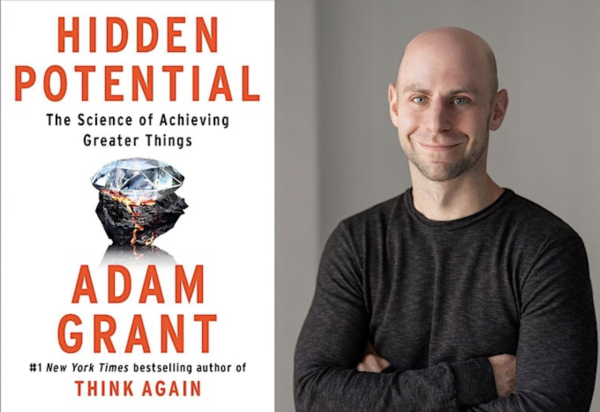2023 has been a year of beginnings and endings for the Goodman Center. I became the new Director, Andy began the next phase of his career as Director Emeritus (the end of an era!), and Madi Goff joined our team.
In this month’s free-range thinking, Andy is popping in with a newsletter item about beginnings, and I thought I’d include some great wisdom to live by for ending strong. Thank you so much for subscribing to our newsletter and being part of The Goodman Center community. We hope that this season brings bright beginnings and satisfying endings to each of you.
Sincerely,
Kirsten Farrell
A New Way to Start When You Want Them to Learn
by Andy Goodman
Looking for an engaging new way to begin your next speech or workshop? If your goal is to have your audience learn something on the spot, you may want to consider the following:
 Adam Grant is a professor at the Wharton School of the University of Pennsylvania who specializes in organizational psychology. He’s currently promoting his new book, Hidden Potential: The Science of Achieving Greater Things, and he was recently interviewed by Malcolm Gladwell at the 92nd Street Y in New York City.
Adam Grant is a professor at the Wharton School of the University of Pennsylvania who specializes in organizational psychology. He’s currently promoting his new book, Hidden Potential: The Science of Achieving Greater Things, and he was recently interviewed by Malcolm Gladwell at the 92nd Street Y in New York City.
During that conversation, Grant asserted there is one human quality that correlates with the ability to learn more strongly than any other. Before Grant continued, you could hear people in the audience whispering to each other what they knew to be the answer: curiosity. But that wasn’t the next word out of Grant’s mouth. It was humility.
Humility, Grant explained, is the willingness to say, “I don’t know.” Or “I may think I know, but perhaps I have it wrong.” Humility is a driver of curiosity, which makes perfect sense. After all, if we think we know something already, why would we be curious to hear more about it?
So, how do you turn Grant’s finding into an opening for your next talk? We recommend briefly sharing the story above, and then explicitly asking your audience to try approaching the rest of your talk with humility: to acknowledge to themselves what they don’t know, or to consider that what they think they know may not be the whole story.
In short, set them up to learn in the best way possible.
Don’t Put a Hat on a Hat
by Kirsten Farrell
As the year comes to a close, we can’t help but think about the importance of a strong ending. Whether it is the end of a story, presentation, pitch, meeting or the end of an era, a year or one day. When we get to the end, we want to know what it all meant. Why have we taken this journey?
One of the biggest problems with endings in public interest communication has been that communicators blow right past them. We finish the slides on our presentation and say, “ok, that’s my last slide, now I’ll take some questions.” There’s no ceremony. No satisfaction.

image by Eric Anada
As a reader of this newsletter or alumni of The Platinum Rules of Presenting, we hope you are well beyond such mistakes. You know to make the ending count. You know to leave your audience with a closing thought – to provide some meaning.
But what happens when we overcorrect? Can we try too hard to make the ending meaningful? Oh yeah… we definitely can. We look straight into the audience’s eyes and say “Let me leave you with one final thought.” We lay it down. The audience starts to applaud but we interrupt, “and in conclusion…” We share another beautiful nugget of wisdom, but before they can rush out of their seats there’s “just one more thing” we want to say, “and I hope you will remember this…” Essentially, we broke a cardinal rule of endings that comes from the world of comedy: we put a hat on a hat.
 In stand-up, sketch and improv comedy, you need a great ending: the perfect punchline or a satisfying callback. But often, a witty writer will come up with more than one great idea. They’ve got two great “last” lines, and if they don’t make a tough editing choice and try to cram in both… they ruin the joke, the scene, maybe the night. That’s what they call putting a hat on a hat.
In stand-up, sketch and improv comedy, you need a great ending: the perfect punchline or a satisfying callback. But often, a witty writer will come up with more than one great idea. They’ve got two great “last” lines, and if they don’t make a tough editing choice and try to cram in both… they ruin the joke, the scene, maybe the night. That’s what they call putting a hat on a hat.
Picture Indiana Jones in his fedora, Sam Jackson in his Kangol or Carmen Miranda in her fruit-filled turban – a good hat can make the man, but a second hat? That’s just silly.
So please, take the time to share one last thought! Give the audience something to inspire them, to move them, and make some meaning. Don’t put a hat on a hat. Know when to say “When!” Leave well enough alone. Wrap it up. Stick the landing. And finally… oh wait, I’m doing it, aren’t I?
